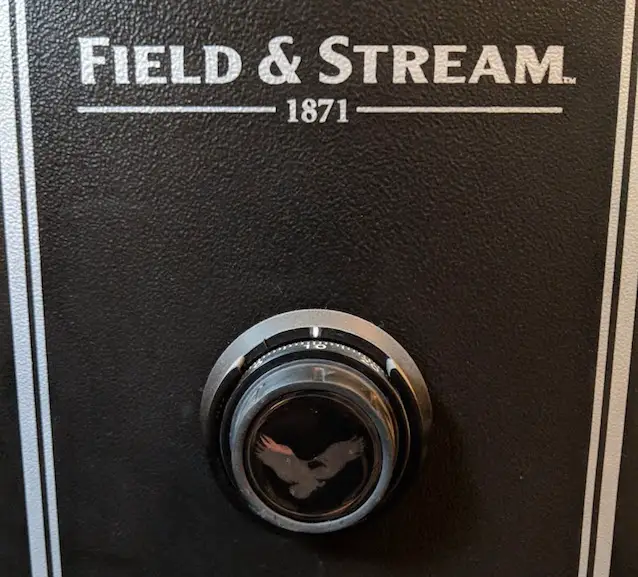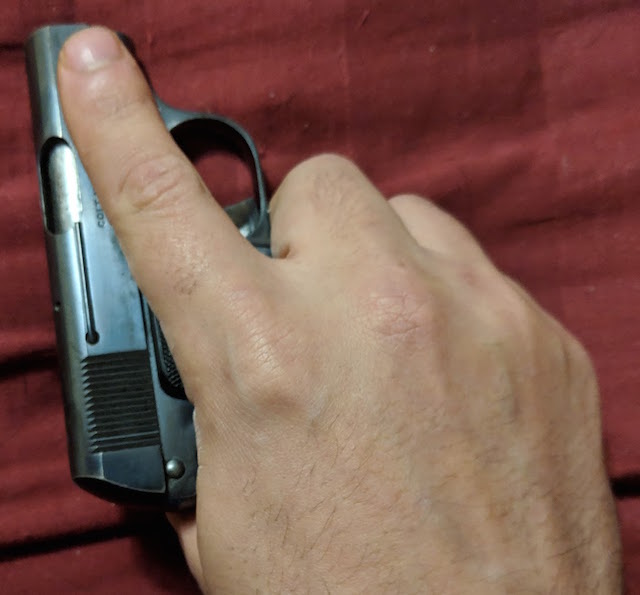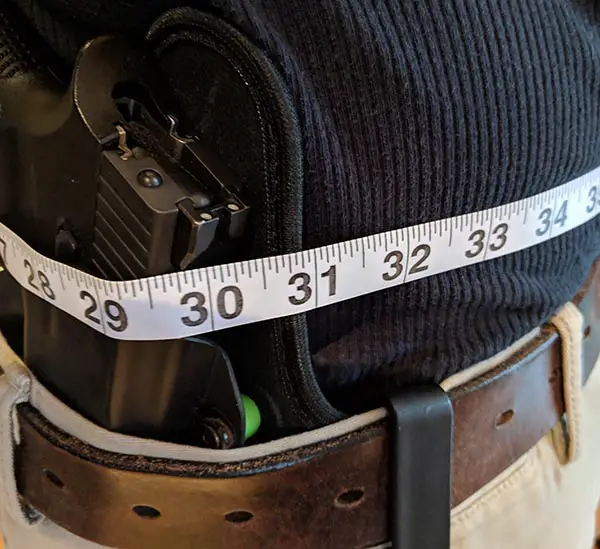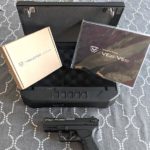When it comes to protecting your family in a life and death situation, your firearm is often your first, last, and only line of defense. Hopefully, you’ve instructed your child in firearm safety and they have a healthy respect for your weapons. But, sometimes your children are too young to comprehend the importance of safely handling firearm. Or, maybe you have guests over frequently, and you don’t want anyone inexperienced with guns to stumble upon yours. In these instances, choosing a gun safe or other secure means of firearm storage are of the utmost importance.
However, what are some considerations you should make when selecting a gun safe? Because a gun safe can be a large investment, considering all of your needs and options is essential.
Table of Contents
Evaluating All Threats
The old adage goes, “guns only have two enemies, rust and politicians” but in reality that’s only partially true. When you own a gun (or multiples) there are other threats you need to prepare for. Let’s dive into what those are:
Theft
When investing in a safe, you should ensure that the locking mechanism is sufficient to prevent professional thieves from having access. I’ve known plenty of firearms enthusiasts whose collections value in the thousands of dollars. Having a safe that is impervious to drilling, with additional safety features that deploy or activate when the lock is tampered with or punched out can help keep your guns secure.
Fire
According to the National Institute for Fire and Safety Training, the average house fire burns at 1,100 degrees Fahrenheit. Pretty warm, but not nearly enough to melt the steel that your safe is likely made out of, which melts at a temperature of around 2,500 degrees Fahrenheit.
However, we’re concerned about the contents of the safe, namely the firearms and peripherals. Since many barrels are made of steel there is a very small likelihood of them melting. Check out the section below where we talk about fire ratings and why they are important.
The biggest security measure, with regard to fire, is to keep your gun safe away from likely sources of a home fire. Store your weapons away from fireplaces, furnaces, and stoves to best ensure the safety of your weapons.
Flooding
If you’ve ever gone down into your basement bathroom to find a pool of standing water, then this is an obvious consideration. While many manufacturers focus on making their gun safes fire resistant, it seems waterproofing their safes are less of a concern.
I recommend finding a safe that is both fireproof and waterproof (at least to some degree) to protect your firearms no matter the disaster. After all, rust is one of the hallmark enemies of firearms. But, it will also likely render your ammunition useless, or at the very least, unreliable.
One more thing to consider; don’t firefighters typically douse a house fire in water to extinguish the flames? Hmmmm…
Gun Safe Sizing
Whether your firearm collection is one pistol, or a combination of pistols, shotguns, and rifles, choosing the correct size safe is important. However, many people neglect to consider the other firearm accessories that they’ll need to store. For instance, do you have any extra magazines you want to keep stored? Many people also choose to keep spare ammunition in their gun safe. Furthermore, if you’re affinity for guns expands, evaluate if your gun safe has room for a growing collection.
However, there’s no reason to go overboard. If you currently only own one gun, you probably won’t need a 12 gun safe that is made to house multiple rifles. If you’re getting into shooting sports or hunting though you may want to invest in a stand up safe to accommodate long guns and shotguns.
Location Of Your Gun Safe
For many, the location where their gun safe will reside is an afterthought. This is particularly true of someone who needs a small gun safe for one pistol. Because the safe is small, they end up clearing a space on their nightstand or dresser, which leaves the safe in plain view. Unfortunately, in the event of a break-in that safe won’t remain secured for long. We’ll talk more about anchoring your gun safe next.
I urge you to consider a dedicated space for your gun safe. Anyone looking to get a gun safe equipped to house long guns should really have the safe in a secured room. I’m currently remodeling my basement and plan on putting in a hidden door to where my large safe is located. I am a firm believer in concealment of your gun safe being one of the best options for securing your firearms at home. An intruder cannot crack a safe, or remove it from your home, if they don’t know it’s there.
For those with a small safe, it can be difficult to find a space that is hidden, yet easily accessible should you need immediate access to your firearm. However, tucking the gun safe into a drawer or in a closet is better than leaving it sitting on the office desk for anyone to see at first glance.
Anchoring Your Gun Safe
In addition to keeping your safe hidden from view, you should also consider a safe that allows you to bold the safe down. Should an intruder discover your gun safe, they shouldn’t be able to move that safe. When my large safe was delivered, the guys loaded it up on a hand truck to maneuver it into my home. Now, don’t get me wrong, the safe is hefty. It’s even heavier when loaded down with my rifles and shotguns, but having an additional layer of keeping your safe in place is never a bad thing.
Ideally, you’ll have your safe anchored to concrete or steel rather than wood. This prevents would be thieves from using the weight of the safe and it’s contents as leverage to pry the bolts out from the studs or floor joists the safe is connected to.
Because I recommend you bolt down your safe, it makes selecting a permanent location all the more important. You don’t want to be moving the safe later and patching the original holes because you failed to think ahead.
Choosing A Locking Mechanism
Keeping your firearm secure doesn’t necessarily mean you won’t have quick access to it should you need your gun. However, you’ll need to evaluate each of the below forms of locking mechanisms to see which best suits your needs.
I recommend purchasing a safe that has multiple means of access. Furthermore, one access point for your gun safe should be mechanical, whether via a key or combination. Batteries fail, and you don’t want to be calling a locksmith over in the middle of a home invasion!
Finally, some locking mechanisms allow for easy reprogramming of the access code, while others will require the assistance of a locksmith. When my safe was delivered, I had to unlock the safe (a dial combination) in front of the delivery man to prove the delivered item was not faulty. Use extra caution, and offer to open the lock yourself to prevent your code from being exposed.
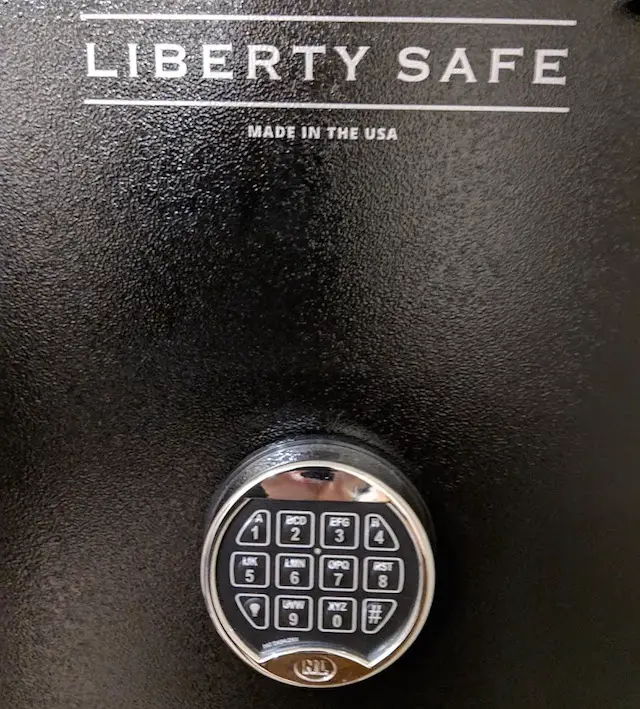
Biometric Entry
Biometric gun safes allow access using fingerprint identification. Many of these models are smaller (though there are larger models too), and can be operated with one hand. You’ll need to program your fingerprints and those of other users into these models. Can be great for spouses or significant others who won’t ever access the firearm unless it’s an emergency.
Electronic Key Pad Combination
These locking mechanisms respond to a numeric code. Often, these are the easiest to reprogram for a new access code. Like the biometric, these units operate using batteries. This is something you’ll need to manage with these units.
Dial Combination Lock
Completely mechanical, and free of batteries, this method is old school but still highly effective with the right configuration. Typically, these units will come with a predefined access code and you’ll need manufacturer or locksmith assistance if you get locked out.
Bluetooth Enabled (Electronic Lock)
While this is not the sole feature, it’s worth mentioning in the digital age in which we live. This feature works in conjunction with a smart phone, and therefore relies on batteries. This technology is a double edged sword. It allows you to monitor safe access and unlock remotely within a certain distance. But anything that relies on an application is only as secure as the application it uses.
Protection Against Fire and Moisture
Fire Ratings
Cartridges are the real concern when fire is present. So, if you plan on stashing ammo in your gun safe, either in a magazine or just excess boxes, you’ll need to pay to fire ratings. A study published on Science Direct, posted findings regarding 7.62 mm cartridges in a simulated heated gun barrel. The propellant used caused the round to “cook off” just above 300 degrees Fahrenheit. It is unclear if this meant the primer or the powder, in either case this temperature is the lowest combustion value I was able to find. This seems fairly consistent with the temperature used in the fire rating structure.
Therefore, you’ll want a gun safe that keeps the internal temperature below this for as long as possible. My research showed that fire ratings can be deceptive, but using these are really the only indicator for measuring effective protection during a fire. Typically, the fire rating is displayed like this:
2 hours @ 1875 ° F
What this means, is that the internal temperature remained below 350 degrees F for 2 hours.
Moisture Control
Another part of maintaining your firearms safety, is being able to control the humidity. Excess moisture in the air can wreak havoc on firearms that are left unattended. Some safes come with pre-drilled holes for wired dehumidifiers, or you can go the cordless route. If you’re on a budget, pick up some desiccant packets to absorb the moisture.
Whatever option you choose, I highly recommend this as an addition to your gun safe purchase. Regardless of your choice, keep in mind that dehumidifiers will have to be renewed periodically (around 30 days depending on the model and moisture levels) and desiccant packets will have to be purged and replaced for optimal moisture control in your gun safe.
Gun Safe Accessories
Many larger safes, equipped to house long guns, may have add on accessories you choose to take advantage of. We’ve already discussed wired de-humidifiers in the moisture control section.
However, you’ll also have access to things like door organizers, which can expand the storage of your firearm safe. Gun safe door organizers are a great way to store pistols, holsters, magazines, and ammunition. Another solution of that ilk, are handgun hangers which can be used in conjunction with your safes’ shelving system.
If you need a little illumination because you’re safe is hidden away in an unlit space, you may also want to invest in some kind of lighting system.
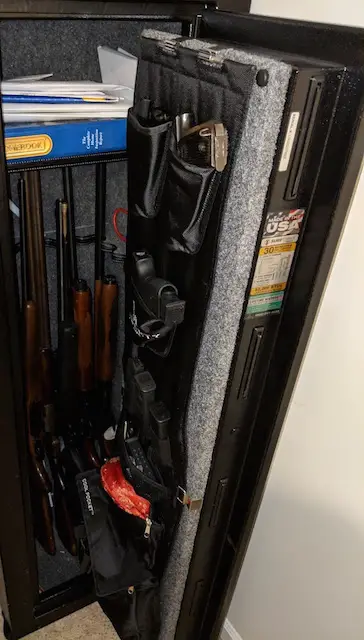
Gun Safe Alternatives
I’ve mentioned that concealment is one of the best forms of security. There are plenty of ways to accomplish this. I’m sure you’ve seen various models of hanging wall art, that double as a way to conceal your firearms. There are also concealment shelves that drop down on hinges to reveal your weapon.
I’ve got the “Keeper” gun magnet (Amazon link) mounted in my room for quick access to my firearm in an emergency. If you’re handy with woodworking, you could probably fashion your own form of concealed gun storage.
One Safe Or Multiples
We’ve discussed the lack of foresight that plagues many gun owners. Believing that you will only ever own the guns currently in your possession is admirable, but unlikely in my experience. Therefore, you may want to invest in multiple storage units, to accommodate a growing firearm collection.
Another reason you may want to invest in an additional gun safe is to provide secure storage for guns at different locations within your home. My goal is to have access to a firearm no matter what room of my home I am in.
Putting all your eggs in one basket can be a deadly mistake. That’s why I recommend having at least two designated storage areas for your firearms. If you’re asleep upstairs with your guns locked up safely in the basement, and an intruder breaks in on the ground floor then you’re in trouble!
Professional Installation or DIY
If you’re uncomfortable with the installation process, then it’s probably best to have your gun safe professionally installed. You may need the assistance of a contractor if you’re bolting in your safe somewhere. Hopefully, you have a handyman or contractor you trust since I wouldn’t recommend throwing darts at the yellow pages.
Also, did I mention that many safes are heavy? Don’t try to move a standing gun safe without assistance, either from a friend of a professional.
Bear all this in mind while you are shopping. Reach out to the customer service department of the safe you plan to buy. Ask them questions about setup and delivery. Evaluating where you plan to place your gun safe (up a flight of stairs, in a basement, etc.) will help when coordinating logistics.
State Regulations For Firearm Storage
Let’s talk about the elephant in the room. Some of you are responsible gun owners who want to protect your investments and safeguard your loved ones. However, there may be some of you who are only doing this because your state may require you to have a qualified storage unit in your home to secure your gun(s). Make sure you check your states code regarding the storage of firearms, and ensure you are in compliance. It’s an expensive mistake to purchase a gun safe that doesn’t meet the legislative requirements!
Your Gun Safe Budget
The amount of money you have to spend on your gun safe is one of the biggest determining factors on what brand, model, etc. you plan to purchase. In all honesty, unless your budget is unlimited, you may have to settle on certain criteria you want. Getting the biggest and baddest gun safe money can be won’t be cheap, so determine what factors are most important given your situation at home. Here are some things that can impact your decision about what gun safe to purchase:
- Are you the only person who needs access to the safe? (spouse, roommate, etc.)
- Do you have children in the house or frequent visitors?
- Are you in a city or other densely populated area prone to break-ins?
- Do you own the property where you’ll be installing the gun safe?
Parting Shots
Choosing a gun safe can be a difficult journey, and you must really look at your own individual requirements. However, because of their cost, you’ll be glad you are informed and had a well thought out plan when you finally make the investment. As a recap, here’s the things you should be considering when choosing the best safe for you:
- Major threat analysis
- Size and storage capacity of your safe
- Location where your safe will reside
- Securing the safe to the structure (anchoring the safe)
- Type of locking mechanism
- Fire and moisture protection
- Gun safe accessories
- Alternative storage means
- Is one safe enough?
- Do you need professional or assisted installation
- State regulations
- Your budget!
Good luck with your search, and please feel free to comment if you found this information useful!
